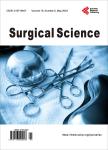Prophylactic Wound Drainage in Orthopaedics: A Comparative Evaluation of Closed Suction Drainage versus No-Drainage in a Nigerian Teaching Hospital
Prophylactic Wound Drainage in Orthopaedics: A Comparative Evaluation of Closed Suction Drainage versus No-Drainage in a Nigerian Teaching Hospital作者机构:Departments of Anaesthesiology University of Calabar Teaching Hospital Calabar Nigeria Departments of Community Medicine University of Calabar Teaching Hospital Calabar Nigeria Departments of Orthopaedics & Traumatology University of Calabar Teaching Hospital Calabar Nigeria
出 版 物:《Surgical Science》 (外科学(英文))
年 卷 期:2013年第4卷第5期
页 面:277-282页
学科分类:1002[医学-临床医学] 100214[医学-肿瘤学] 10[医学]
主 题:Wound Drain No-Drain Complications Orthopaedics
摘 要:Background: Surgical wound drainage is practiced routinely by many orthopaedic surgeons despite studies that challenge the practice. Among proponents, the advantages of drainage include prevention of haematoma and/or seroma formation which potentially reduces the chances for infection, prevention of wound swelling, prevention of compartment syndrome and improvement of the local wound environment. Opponents argue that prophylactic wound drainage confers no significant advantages, increases the risk of infection and the need for blood transfusion with the attendant risks of this therapy. Aim: To ascertain if prophylactic drainage of clean orthopaedic wounds confer any significant advantages by evaluating wound and systemic factors in two treatment groups. Patients and Methods: A prospective analysis of 62 patients was undergoing clean orthopaedic procedures. The patients were randomly assigned to a “No drain (study) group and a “drain (control) group. Each group had 31 patients. Surgeons were blinded to the randomization process and the evaluation of clinical outcomes. The parameters assessed included pain, superficial wound infection, the need for post-operative transfusion, wound leakage, dressing changes and the surgery-discharge interval. Data was analysed using SPSS statistics version 20 (IBM Corp., New York). Results: There were no significant differences in the demographic data. Femoral fractures were the commonest indication for surgery (43.55%), and plate and screw osteosynthesis was the commonest procedure (48.4% in the drain group and 67.7% in the no-drain group). There was a significantly higher need for post-operative transfusion in the drain group (22.6% against 0%) as well as a significantly prolonged capillary refill time (2.39 + 0.56 secs versus 2.03 + 0.41 secs). Although not statistically significant, there were four cases (12.8%) of superficial wound infection in the drain group and 1 case (3.2%) in the no-drain group. Conclusion: Prophylactic wo



